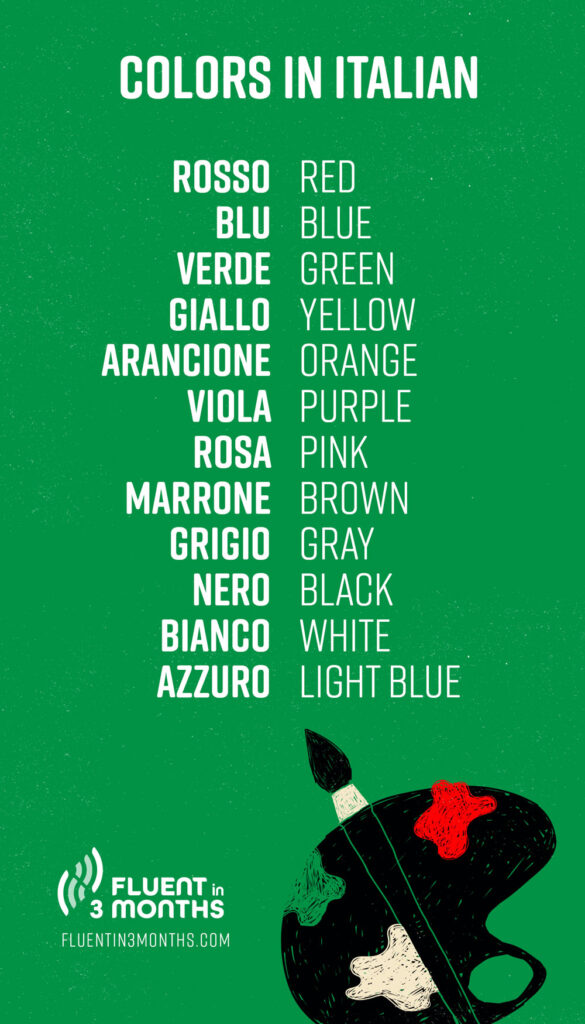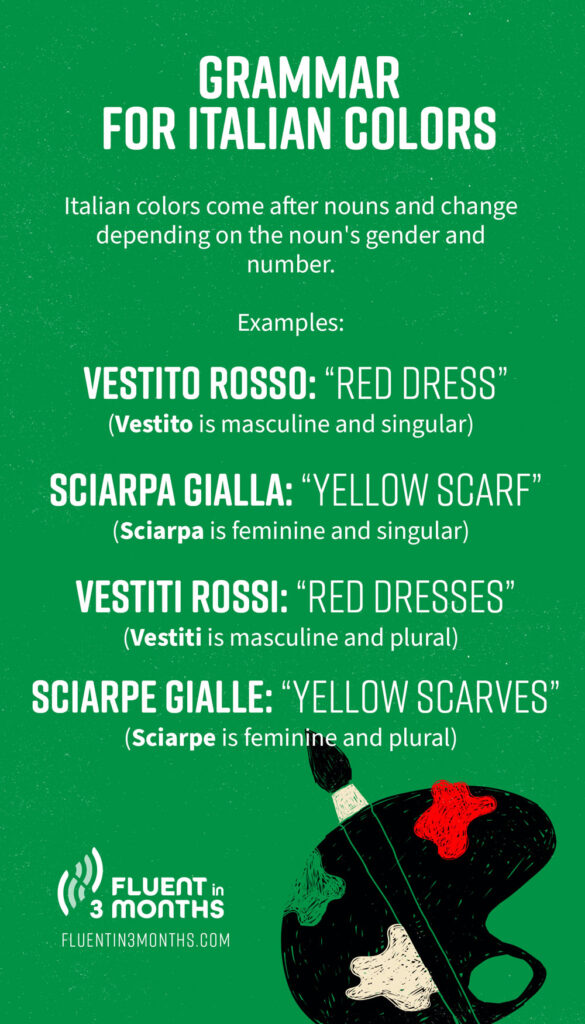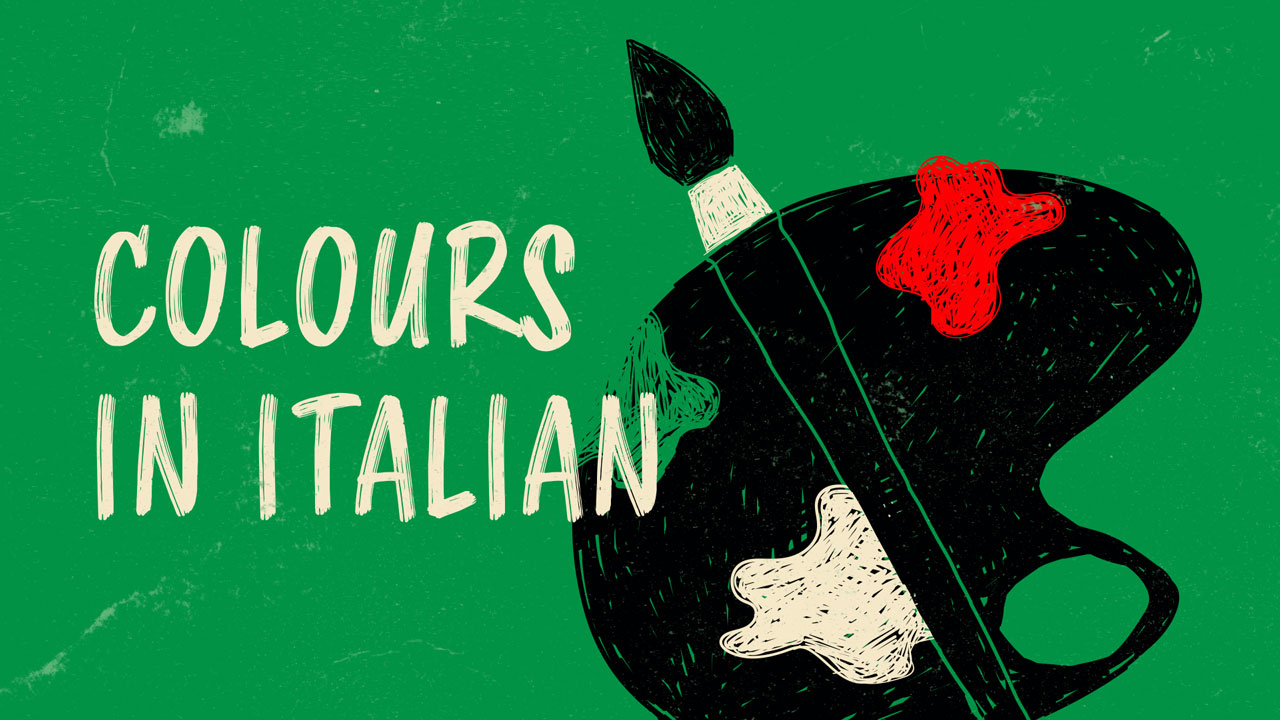Learn Colors in Italian (With Audio)
Learn colors in Italian to start describing nouns, order gelato of all colors in Italy, shop for clothes, and more! In Italian, colors have to agree with both the gender and the number of the noun they are describing. This means that their endings can change depending on the context. We’ll explain why and how, right after we cover the most important colors in Italian.
Table of contents
Colors in Italian: I Colori
Let’s start with the basics. Here are the most common colors in Italian:

| Colors in Italian | ||
|---|---|---|
| Italian | English | Audio |
| Rosso | Red | |
| Blu | Blue | |
| Verde | Green | |
| Giallo | Yellow | |
| Arancione | Orange | |
| Viola | Purple | |
| Rosa | Pink | |
| Marrone | Brown | |
| Grigio | Gray | |
| Nero | Black | |
| Bianco | White | |
| Azzuro | Light blue | |
How to Use Italian Colors in a Sentence
In Italian, colors come after the noun. For example, the correct translation of “black jacket” would be giacca nera and not nera giacca. Notice how we said nera instead of nero? That’s because Italian colors need to agree with the gender of the noun.
Here are some other examples:
- Vestito rosso: “Red dress” (Vestito is masculine)
- Sciarpa gialla: “Yellow scarf” (Sciarpa is feminine)
To make Italian nouns plural, we need to change the ending. Nouns ending with -o and -e change into -i, and nouns ending with -a into -e. Colors also need to adapt when representing plural nouns.
Now, let’s take a look at the examples above and turn them into plural.
- Vestiti rossi: “Red dresses”
- Sciarpe gialle: “Yellow scarves”

This applies to almost all colors, with a few exceptions. Colors rosa, blu and viola are always written the same way, no matter the gender or the number of the noun.
- Libri rosa: “Pink books” (Although libri is the plural of libro, rosa stays the same.)
- Porte viola: “Purple doors” (Porte is the plural form of porta, a feminine noun. Viola stays the same.)
- Sedie blu: “Blue chair” (Sedie is the plural of sedia.)
We should also pay attention to the plural form of bianco, the color “white.” Instead of bianci or biance, we say bianchi for masculine plural and bianche for feminine plural.
To use colors in a sentence, you can combine them with the adjectives as we did above, or with the verb essere, “to be.”
- Il gatto grigio ha fame: “The grey cat is hungry.” (Gatto is a masculine word so we used the masculine article il and grigio in its masculine form.)
- La mia amica vive nella casa rosa: “My friend lives in the pink house.” (Casa is feminine so we used the feminine article la.)
Quick recap of the verb essere, which we’ll use in the following sentences:
| Italian | English | Audio |
| Io sono | I am | |
| Tu sei | You are | |
| Lui/lei è | He/she is | |
| Voi siete | You are | |
| Loro sono | They are |
- “What is your favorite color?”
- : “My favorite color is green.”
- : “The roses are red.” (In Italian, “rose” is rosa, and it’s a feminine word. Rose is the plural of rosa, used in this sentence with the plural feminine article le and the plural feminine form of the color red, rosse.)
- : “The plates are brown.” (Piatto is “plate” in Italian, and it’s masculine. Here, it’s in its plural form, piatti so we used the plural masculine article i and the plural version of marrone which is marroni.
How to Say Dark and Light in Italian
In Italian, dark is scuro and light is chiaro. When used after the color, they give us a clearer picture of what the object looks like.
- Rosso scuro: “Dark red”
- Il mio vestito è rosso scuro: “My dress is dark red.”
- Viola chiaro: “Light purple”
- La tua camicia è viola chiaro: “Your shirt is light purple.”
Learning Italian Will Now Be More Colorful!
Once you master the colors, consider moving on to other common Italian words, such as clothes, food, or animals. This way, you’ll practice colors while learning new words.



Social